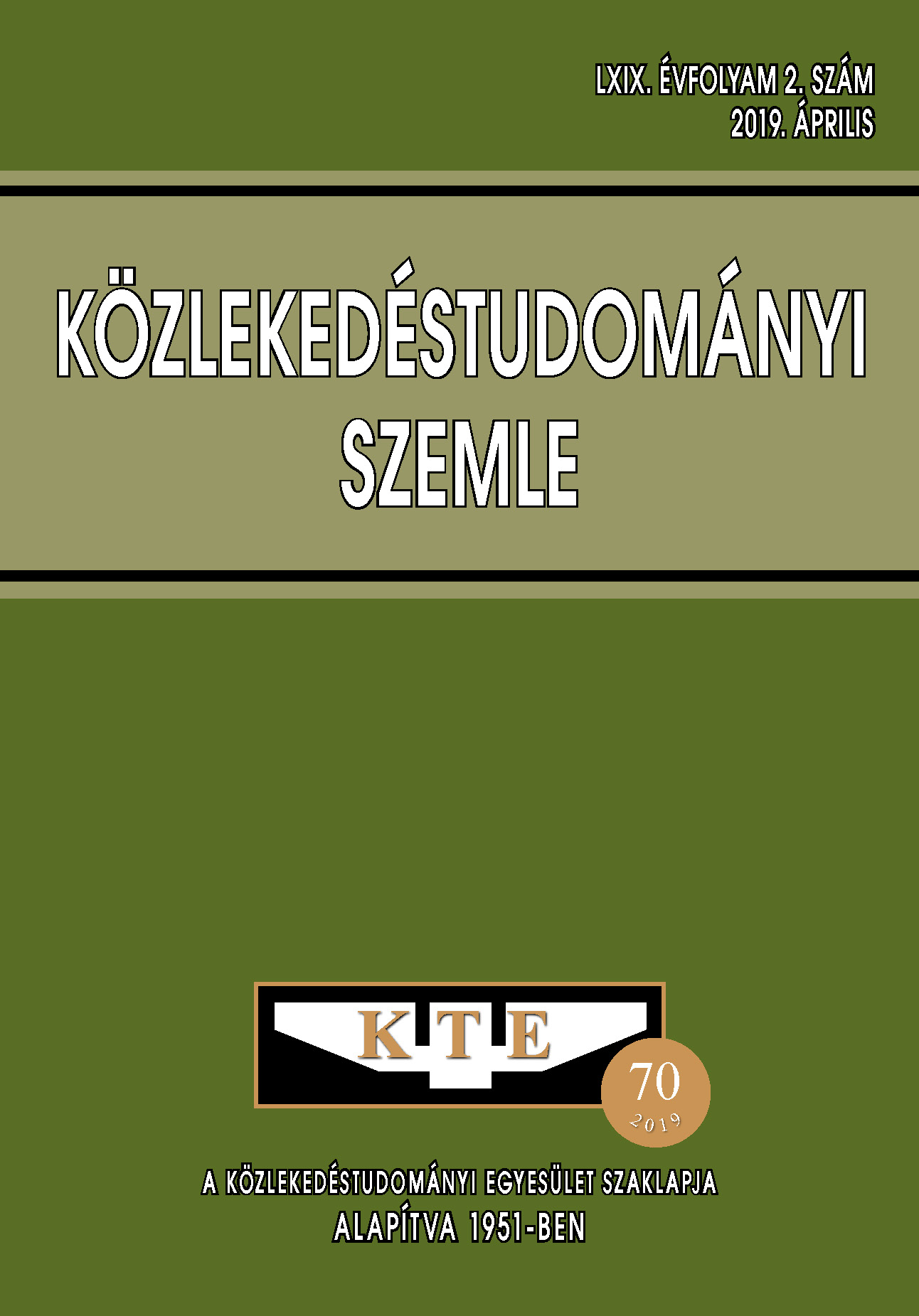Az ingázásból származó ökológiai lábnyom csökkentésének lehetőségei a közösségi gazdaság révén a budapesti városrégióban
Absztrakt
A Budapest körül zajló szuburbanizáció és városi szétterülés, valamint a munkahelyek elővárosi centrumokba települése az ezredforduló óta az ingázás és a hozzá kapcsolódó járműforgalom jelentős növekedését hozta magával. A szerzők arra keresik a választ, hogy a közösségi gazdaság nyújtotta alternatív közlekedési lehetőségek – az autómegosztó és a telekocsi szolgáltatások – milyen jelentőséggel bírnak az ingázásban, s milyen szerepet játszhatnak a városrégió ökológiai lábnyomának csökkentésében.
Hivatkozások
Anielski, M. (2010): Edmonton’s Ecological Footprint. The Edmonton Sustainability Papers 12.
Bálint, D. – Trócsányi, A. (2016): New ways of mobility: the birth of ridesharing. A case study from Hungary. Hungarian Geographical Bulletin 65(4): 391–405. DOI: http://doi.org/c2gt
Becker, H. – Loder, A. – Smid, B. – Axhausen, K-W. (2017a): Modeling carsharing membership as a mobility tool:
A multivariate Probit approach with latent variables. Travel Behaviour and Society 8():26-36. DOI: http://doi.org/c28d
Belk, R. (2014): You are what you can access: Sharing and collaborative consumption online. Journal of Business
Research 67(8):1595–1600. DOI: https://doi.org/10.1016/j.jbusres.2013.10.001
Bessenyei, Gy (2014): Városi mobilitás - Közösségi megoldások. Közlekedéstudományi Szemle. 54 (1) 24-28.
Botsman, R. – Rogers, R. (2010): What's mine is yours: the rise of collaborative consumption. First edition, HarperCollins Publishers, New York.
Braun, A. (2017): Car-less or car-free? Socioeconomic and mobility differences among zero-car households. Transport Policy 60.():152-159. DOI: http://doi.org/gcpcfm
BSDC (2017): Better Business Better World. The report of the Business & Sustainable Development Commission. http://report.businesscommission.org/uploads/BetterBiz-BetterWorld_170215_012417.pdf
Conner-Simons, A. (2016): Study: Carpooling apps could reduce taxi traffic 75%. News. Retrieved from https://www.csail.mit.edu/ridesharing_reduces_traffic_300_percent
Deloitte (2017): Car Sharing in Europe – Business Models, National Variations and Upcoming Disruptions. https://www2.deloitte.com/content/dam/Deloitte/de/Documents/consumer-industrial-products/CIP-Automotive-Car-Sharing-in-Europe.pdf
Deloitte (2016): Economic effects of ridesharing in Australia. Retrieved from https://www2.deloitte.com
Felländer, A. – Ingram, C. – Teigland, R. (2015): Sharing economy — Embracing change with caution. Näringspolitiskt Forum Rapport 11. 70 p. http://eng.entreprenorskapsforum.se/2015/08/21/sharing-economy-embracing-change-withcaution
Ferrero, F. – Perboli, G. – Rosano, M. – Vesco, A. (2018): Car- sharing sevices. An annoted review. Sustainable Cities and Society 37():501-518. DOI: http://doi.org/c28f
Friedman, G. (2014): Workers without employers: shadow corporations and the rise of the gig economy. Review of Keynesian Economics, 2 (2) 171-188.DOI: http://doi.org/gckft5
Frost & Sullivan (2010): Car sharing: Driving the way to a greener future. http://www.frost.com/sublib/display-report.do?id=MB41-01-00-00-00
Kiss J. P. – Szalkai G. (2018): Az ingázás mobilitási jellemzői a legutóbbi népszámlálások adatai alapján. Területi Statisztika 58(2): 177–199.
Kovács Z. – Szigeti C. – Egedy T. – Szabó B. – Kondor A. Cs. (2017): Az urbanizáció környezeti hatásai - az ingázás ökológiai lábnyomának változása a budapesti várostérségben. Területi Statisztika 57 (5): 469-494.
Marteen, E. – Shaheen, S. (2011): Greenhouse Gas Emission Impacts of Carsharing in North America IEEE Trans.
Intell. Transp. Syst. 12. 1074–1086. DOI: http://doi.org/cn2s4n
MIT (2016): https://www.csail.mit.edu/ridesharing_reduces_traffic_300_percent
MIT (2009): „Real-Time" Rideshare Research 2009: http://ridesharechoices.scripts.mit.edu/home/histstats/
Perboli, G. – Ferrero, F. – Musso, S. – Vasco, A. (2017): Business modell and tariff simulation in carsharing services.
Transportation Research.Part A 115():32-48 DOI: http://doi.org/gcsjsm
Petrini, M. – Freitas, C. S. de. – Silveira, L. M. da S. 2017: A Proposal for a Typology of Sharing Economy. Revista de
Administração Mackenzie, 18(5):39-62.
PWC (2016): Shared benefits. https://www.pwc.co.uk/issues/megatrends/collisions/sharingeconomy/future-of-the-sharingeconomy-in-europe-2016.html
Richardson, L. (2015): Performing the sharing economy. Geoforum, 67: 121-129.
Rinne, A. (2017): What exactly is the sharing economy? World Eocnomic Forum. https://www.weforum.org/agenda/2017/12/when-is-sharing-not-really-sharing
Santoso, A.S. – Nelloh, L.A.M. (2017): User Satisfaction and Intention to Use Peer-to-Peer Online Transportation: A Replication Study. Procedia Computer Science 124():379–387. DOI: http://doi.org/c28g
Schmöller, S. – Weikl, S. – Müller, J. – Bogenberger, K. (2015): Empirical analysis of free-floating carsharing usage: The Munich and Berlin case. Transportation Research Part C: Emerging Technologies 56():34-51. DOI: http://doi.org/f7hr8m
Schor, J. B. (2014): Great Transition Iniciative. www.greattransition.org/publication/debating-the-sharing-economy
Szabó, T. – Szabó, B. – Kovács, Z. (2014): Polycentric urban development in postsocialist context: the case of the Budapest Metropolitan Region. Hungarian Geographical Bulletin 63 (3): 287–301. DOI: http://doi.org/9bq
Wallenstein, J. – Shelat, U. (2017): What’s next for the sharing economy? BCG Henderson Institute. https://www.bcg.com/publications/2017/strategy-technologydigital-whats-next-for-sharing-economy.aspx
Wilson J. – Anielski, M. (2015): Saskatoon Ecological Footprint. City of Saskatoon Ecological Footprint Report 2014 https://www.saskatoon.ca/sites/default/files/documents/corporate-erformance/environmentalcorporate-initiatives/communityenvironmental-programs/saskatoon_ef_city_report_2015_feb_28_2016_final.pdf
Az elektronikusan megjelenő cikkek nyílt hozzáféréssel rendelkeznek (OJS), online ingyenesen elérhetők és letölthetők. A cikkek szerzőit nem terheli megjelentetési vagy kiadási költség (APC). Felhasználóknak joguk van a cikkek olvasására, letöltésére, másolására, kinyomtatására, valamint azokban való keresésre, vagy a teljes szöveg linkkel történő megosztására.
A szerzőknek nyilatkozniuk kell arról, hogy beadványukat korábban nem tették közzé más folyóiratban, a pénzügyi támogatás feltüntetésre került és a hivatkozások listája teljes és pontos, beleértve az URL-ek és a DOI-k specifikációját is (ha rendelkezésre állnak). A cikktervezet beadásakor minden szerző jóváhagyja a benyújtott változatot. A szerzők garantálják, hogy a cikk az ő eredeti művük. A szerzők kötelesek részt venni a szakértői értékelés folyamatában, követni a bírálók tanácsait, betartani az előírt határidőket, és amennyiben előfordulnak, kötelesek visszavonni a benyújtást vagy kijavítani a hibákat.
Minden beadott cikket szakértői értékelés alá kerül, ahol a szerkesztők független értékelést kérnek legalább egy szakértőtől, ügyelve arra, hogy a bíráló(k)nak ne legyen összeférhetetlensége a szerzőkkel. A végső döntést a főszerkesztő hozza meg, aki figyelembe veszi az értékeléseket és a szerkesztők javaslatait. A szerkesztők és a lektorok bizalmasan kezelik a beadványt.
A kiadó és a szerkesztők elkötelezettek a magas etikai normák betartása mellett, és megakadályozzák azokat a publikációkat, amelyekben kutatási visszaélés történt. Az ilyen etikai kérdésekben a COPE irányelveit követik.
A szerzők fenntartják a szerzői jogokat, és megadják a folyóiratnak az első közzétételi jogot a Creative Commons Licenc alapján (https://creativecommons.org/licenses/by-nc-nd/4.0), amely lehetővé teszi mások számára, hogy megosszák a művet, elismerve a mű szerzőségét és a folyóiratban való első közzétételt.
A folyóirat archiválja az összes megjelent cikket, és a folyóirat tulajdonosa, a Közlekedéstudományi Egyesület továbbra is üzemelteti az adatbázist abban az esetben is, ha a folyóirat kiadása megszűnik.















